New video tip from PPSOP founder Bryan Peterson!
Friday, November 5, 2010
Wednesday, November 3, 2010
Wednesday, July 14, 2010
A Different Perspective on Pet Photography by Jill Flynn
If you follow your pets around the house and outside, they will lead you to your next
memorable portrait. Always listen to your animals and take what they give you - it beats a posed shot any day. Whether it's natural light portraits, studio style portraits or outdoor portraits, find or create beautiful light and photograph your animals being themselves. Keeping it simple is sometimes the best idea.
Photos of animals sleeping make wonderful portraits. I don't know any dog or cat that does not like to take a nap. If they have a favorite chair, couch, blanket, etc., position it in a room that has good light. A nice big window with diffused light at a 45-degree angle will illuminate your pet beautifully. Remember you want a room filled with beautiful light not direct sunlight. Patience is key, so keep your camera on hand and when your pet finally takes a nap, seize the moment. A splash of color can make a portrait pop. If you don't have colorful furniture, you can place a colorful blanket on top. My dog, Gracie, loves her afternoon siesta. I photographed her from a slightly high angle looking down so I could show her face being framed between her two paws and to accentuate the long, elegant lines of her nose and paws.


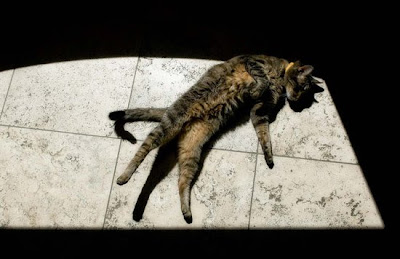
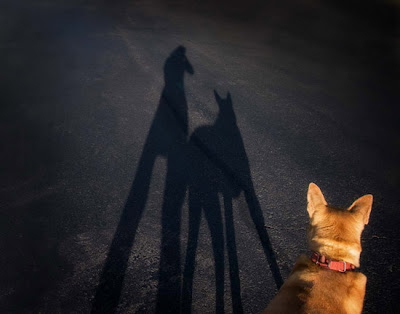
If you follow your pets around the house and outside, they will lead you to your next
memorable portrait. Always listen to your animals and take what they give you - it beats a posed shot any day. Whether it's natural light portraits, studio style portraits or outdoor portraits, find or create beautiful light and photograph your animals being themselves. Keeping it simple is sometimes the best idea.
Photos of animals sleeping make wonderful portraits. I don't know any dog or cat that does not like to take a nap. If they have a favorite chair, couch, blanket, etc., position it in a room that has good light. A nice big window with diffused light at a 45-degree angle will illuminate your pet beautifully. Remember you want a room filled with beautiful light not direct sunlight. Patience is key, so keep your camera on hand and when your pet finally takes a nap, seize the moment. A splash of color can make a portrait pop. If you don't have colorful furniture, you can place a colorful blanket on top. My dog, Gracie, loves her afternoon siesta. I photographed her from a slightly high angle looking down so I could show her face being framed between her two paws and to accentuate the long, elegant lines of her nose and paws.

My cat, Murphy, likes to hang out in the bathtub. I don't know if it's because it's cooler in the tub or if it's because it's one of the few places Gracie doesn't hassle him ... maybe it's a little bit of both. Either way he loves the tub and looks so cute in there. Cats are always hanging out in unique places. Photograph your cat in their favorite spot. Bathrooms often have great light and a white tub will provide even more light. Many cats like to sit inside sinks. That is another great spot for a portrait. Get your pet to look at the camera, focus on the eyes, make it personal, and capture their personality. Make sure you illuminate the face with diffused light - that will bring out detail, color and give spark/life to the eyes. It will make all the difference in the world. Positioning your main light source at a 45-degree angle is a good start and will give you flattering results.

My cat, Mister, is a sun worshiper. He loves to bask in the sun. My kitchen gets bright afternoon sun and Mister is always there. Direct sunlight is not flattering light, but it will give you interesting shadows and contrasts. I love Mister's "three legged shadow" and face shadow. I also love the interplay of light and shadow on the tile. The strong contrast makes a visual impact and the window light provides very cool framing. Underexpose by 1 or 2 stops to make the shadows darker or play around with the exposure until you get the look you want. I stood on a chair and shot down so I could take in the whole scene. My cat "gave me this shot,"- thank goodness I was paying attention! Stand on a chair or ladder for unique perspectives and use the environment and shadows creatively to tell your story.

Next time you walk your dog, take your camera and be on the lookout for neat shadows. Shadows are longer late in the day or early in the morning when the sun is low in the sky. I took this picture of my dog, Friday, and me in the middle of the street. The light was behind us and I loved the way it illuminated Friday. Since it was late in the day, the light was warm and the shadows long. It was great. I showed just a portion of Friday's head in the lower portion of the frame to make it personal and add some color and fur. This is one of my favorite and last photos I took of Friday. She loved to go for walks. It will always have special meaning for me because it shows the bond we had and our daily ritual. She passed away a few weeks ago. She was 15 1/2 years old. I miss her dearly and I miss our walks. Try to capture the special relationship between you and your pet. Take pictures EVERY chance you get. They are ALL special. When taking shadow shots like this, underexpose by 1 stop or more to make the shadows darker and more defined. You can also enhance or give your image a boost with Levels and Curves adjustment in
PhotoShop. It's all part of the workflow and the creative process. I added a dark vignette around the edges to emphasize the shadows.
PhotoShop. It's all part of the workflow and the creative process. I added a dark vignette around the edges to emphasize the shadows.

Take cues from your pets and capture those everyday moments. They end up being the most memorable and special portraits ... and always photograph what you love.
Jill Flynn
www.visualharmonyphotography.com
Jill teaches the following courses:
Pet Photography
Photography Adventure Course 2
Jill Flynn
www.visualharmonyphotography.com
Jill teaches the following courses:
Pet Photography
Photography Adventure Course 2
Tuesday, July 13, 2010
Learning to see…
Learning to see creatively is very dependent on what your camera and lens can and cannot see. Captains of ships need to become very familiar with their maps as they navigate the world, making certain to keep the ship pointed in the right direction. In much the same way, your lenses are maps that can lead you to new and enchanting lands. With constant practice, which will only come by placing the camera and lens to your eye, you’ll begin to visually memorize the unique vision of each and every lens—both the pluses and the minuses. The more you do this, the less likely you’ll be hearing yourself ask the question, “what lens should I use?” You’ll learn just how vast an area a wide-angle lens can cover, or how a telephoto lens can select a single subject out of an otherwise busy and hectic scene. It won’t be too much longer until you’ll find yourself knowing, without hesitation, what lens to use as you see one picture-taking opportunity after another.
Then, you can begin to take this new found vision to even greater heights, challenging yourself to view the forest from a toad’s point of view, or the city streets from a sidewalk point of view, or your backyard from a robin’s-nest point of view. (Ladders are not just for house painting.) Lie on your back at the base of a large fir tree and show me the point of view of the squirrel that raced up it only moments ago. Set your camera on the shoulder of the road, and fire away just as the big semi truck comes into view. A composition like this will, for example, make it dramatically obvious why it is so important that the city council build a small underpass for the ducks that cross that same busy road every spring.
Whether or not your compositions are compelling depends not on some magic recipe, but rather on a thorough understanding of lens choice, point of view, elements of design, and final arrangement, or composition. All of these are, as I said, “maps” that require studying, some more then others. Both your fears and preconceived notions will be challenged. How will you ever share with others the robin’s-nest viewpoint if you’re afraid of heights? How will you share the busy sidewalk view if the idea of lying down on the sidewalk is too intimidating? You’ll certainly hit a “reef” now and then, and you may even feel compelled to abandon ship at times.
What If. . . ?
Once you begin making discoveries about how your lenses see, don’t be surprised if you find yourself at times consumed by the question “What if. . . ?” What if you focus close on your toaster that just burnt the toast and, as the blue smoke rises from inside, we see your wife—with the baby in her arms—out of focus in the background, running towards it? What if you focus on a passport lying on the sidewalk and we see an obvious out of focus businessman getting into a taxi in the background? What if you focus on a bottle of sleeping pills with an out of focus woman asleep in her bed in the background? What if from inside the house or garage, you focus close on a broken window-pane with an out of focus solemn-looking little boy, glove and bat in hand, in the yard in the background? What if you focus on just the thumb of a hitchhiker on a busy interstate? What if you focus close on just the used syringe in an alleyway? What if you focused close just on the. . . ?
Our desire to see objects up close is innate- a longing for intimate encounters perhaps. And when we combine an up close and personal view of a given subject, we can in turn control the subjects “visual weight” via the proper selection in aperture. It is the aperture in combination with the close focus that determines the overall sharpness in a given scene. And in both of the finished examples shown here, focusing close and the use of a large lens opening, f/5.6, emphasizes the foreground flowers, and in turn the background is rendered into out of focus shapes and tones. It’s as if the flowers have been given a voice, a voice that says quite simply, “Look where I get to bloom!”
The very small village of Jarnioux, France is listed as one France’s Most Beautiful Villages and for good reason. I have shot in Jarnioux more then a dozen times, during all seasons and I never ceased to be amazed at making new discoveries here. As we can see in the first example, the village boasts an old church and castle, and along it’s nearby fields and roadside ditches one can often find wildflowers blooming in the spring and summer. After shooting the first image:
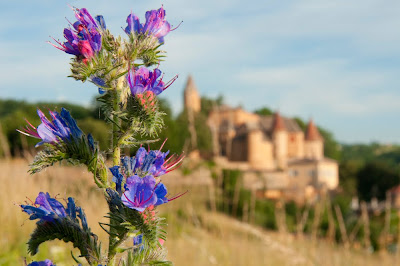
As this second photograph shows, it’s as if the flowers are now exclaiming, “Look where I get to bloom!”
The Valensole Plain in Provence France is a lavender shooters paradise. Once you drive up on any number of small roads that lead to the top of the plain, you will be greeted with waves of lavender as far as the eye can see. It’s an area that is truly hard to take a bad picture! However, having shot ‘waves of lavender’ many times already, I was once again looking for something new. It was then I spotted these yellow flowers in a large expansive field of lavender.
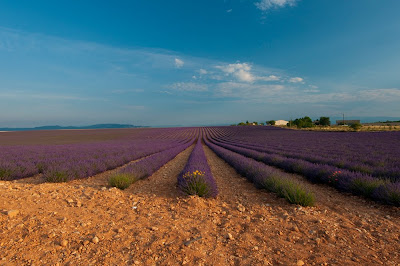
Nikon D300S, Nikkor 70-300mm ED-IF VR, f/5.6 @ 1/1000 second, ISO 200
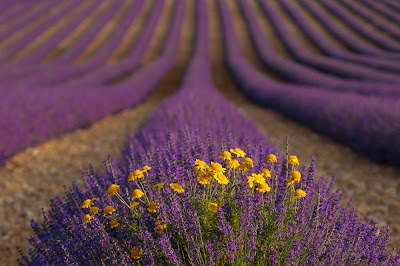
Nikon D300S, Nikkor 70-300mm ED-IF VR, f/5.6 @ 1/1000 second, ISO 200
Get to know your lenses and their unique visions and instead of asking what lens should I use, you will soon be asking “what if…”
Learning to see creatively is very dependent on what your camera and lens can and cannot see. Captains of ships need to become very familiar with their maps as they navigate the world, making certain to keep the ship pointed in the right direction. In much the same way, your lenses are maps that can lead you to new and enchanting lands. With constant practice, which will only come by placing the camera and lens to your eye, you’ll begin to visually memorize the unique vision of each and every lens—both the pluses and the minuses. The more you do this, the less likely you’ll be hearing yourself ask the question, “what lens should I use?” You’ll learn just how vast an area a wide-angle lens can cover, or how a telephoto lens can select a single subject out of an otherwise busy and hectic scene. It won’t be too much longer until you’ll find yourself knowing, without hesitation, what lens to use as you see one picture-taking opportunity after another.
Then, you can begin to take this new found vision to even greater heights, challenging yourself to view the forest from a toad’s point of view, or the city streets from a sidewalk point of view, or your backyard from a robin’s-nest point of view. (Ladders are not just for house painting.) Lie on your back at the base of a large fir tree and show me the point of view of the squirrel that raced up it only moments ago. Set your camera on the shoulder of the road, and fire away just as the big semi truck comes into view. A composition like this will, for example, make it dramatically obvious why it is so important that the city council build a small underpass for the ducks that cross that same busy road every spring.
Whether or not your compositions are compelling depends not on some magic recipe, but rather on a thorough understanding of lens choice, point of view, elements of design, and final arrangement, or composition. All of these are, as I said, “maps” that require studying, some more then others. Both your fears and preconceived notions will be challenged. How will you ever share with others the robin’s-nest viewpoint if you’re afraid of heights? How will you share the busy sidewalk view if the idea of lying down on the sidewalk is too intimidating? You’ll certainly hit a “reef” now and then, and you may even feel compelled to abandon ship at times.
What If. . . ?
Once you begin making discoveries about how your lenses see, don’t be surprised if you find yourself at times consumed by the question “What if. . . ?” What if you focus close on your toaster that just burnt the toast and, as the blue smoke rises from inside, we see your wife—with the baby in her arms—out of focus in the background, running towards it? What if you focus on a passport lying on the sidewalk and we see an obvious out of focus businessman getting into a taxi in the background? What if you focus on a bottle of sleeping pills with an out of focus woman asleep in her bed in the background? What if from inside the house or garage, you focus close on a broken window-pane with an out of focus solemn-looking little boy, glove and bat in hand, in the yard in the background? What if you focus on just the thumb of a hitchhiker on a busy interstate? What if you focus close on just the used syringe in an alleyway? What if you focused close just on the. . . ?
Our desire to see objects up close is innate- a longing for intimate encounters perhaps. And when we combine an up close and personal view of a given subject, we can in turn control the subjects “visual weight” via the proper selection in aperture. It is the aperture in combination with the close focus that determines the overall sharpness in a given scene. And in both of the finished examples shown here, focusing close and the use of a large lens opening, f/5.6, emphasizes the foreground flowers, and in turn the background is rendered into out of focus shapes and tones. It’s as if the flowers have been given a voice, a voice that says quite simply, “Look where I get to bloom!”
The very small village of Jarnioux, France is listed as one France’s Most Beautiful Villages and for good reason. I have shot in Jarnioux more then a dozen times, during all seasons and I never ceased to be amazed at making new discoveries here. As we can see in the first example, the village boasts an old church and castle, and along it’s nearby fields and roadside ditches one can often find wildflowers blooming in the spring and summer. After shooting the first image:
The thought then occurred to me, “What if I could show the village of Jarnioux from the flowers perspective, as if the flowers wanted everyone to know where they lived?” With the aid of my Nikkor 28-70mm f/2.8 lens I was able to move in really close to a single flower stalk and when combined with a large lens opening, I was able to give the flowers a voice.

As this second photograph shows, it’s as if the flowers are now exclaiming, “Look where I get to bloom!”
The Valensole Plain in Provence France is a lavender shooters paradise. Once you drive up on any number of small roads that lead to the top of the plain, you will be greeted with waves of lavender as far as the eye can see. It’s an area that is truly hard to take a bad picture! However, having shot ‘waves of lavender’ many times already, I was once again looking for something new. It was then I spotted these yellow flowers in a large expansive field of lavender.

Nikon D300S, Nikkor 70-300mm ED-IF VR, f/5.6 @ 1/1000 second, ISO 200
I new I could once again place the visual weight on these flowers and render the waves of lavender as out of focus shapes and tones in the background. Again, I was able to give the flowers a voice.

Nikon D300S, Nikkor 70-300mm ED-IF VR, f/5.6 @ 1/1000 second, ISO 200
As the second photograph clearly shows, “Look where we get to bloom!”
Get to know your lenses and their unique visions and instead of asking what lens should I use, you will soon be asking “what if…”
Friday, July 9, 2010
MAKING A SPLASH
A tip from PPSOP instructor David Nightingale
One of the hardest photographic lessons to learn is that your camera sees things differently to you. For example, when you shoot a backlit portrait and rely on your camera's meter to determine the exposure, you will often find that you end up with a shot where your subject is too dark and the background is too bright. The problem here is that our ability to perceive dynamic range - the ratio between the darkest and lightest areas of a scene, or 'contrast ratio' - far exceeds the sensitivity of our camera's sensor, i.e. it's just not capable of recording detail in both the brightest AND darkest areas simultaneously. In these circumstances then, we have three choices. First, we can wait for better light, or move our subject into the shade. Second, we can artificially lower the contrast ratio between our subject and background by adding some light using fill-flash or a reflector. Both of these methods will reduce the contrast ratio between your subject and the background, allowing you to record detail in both areas of the image. Third, rather than relying on your metered exposure you can take a meter reading from your subject rather than the scene as a whole. This will lighten your subject, but will probably blow out at least some of the details in the background. Whichever of these methods you use, you can guarantee that it will produce a better image than the metered exposure.
In the example we're going to discuss in this week's tip though we have the opposite problem, i.e. the contrast ratio between the darkest and lightest areas of the original scene is quite low. If you take a look at the original image (a shot of a waterfall at the Dubai International Financial Centre) you will see what I mean - it's a rather dull, flat shot.
If we take a look at the histogram we can see why: the majority of the tones are bunched just to the left of the middle. In other words, we have lots of fairly dark mid-tone values but relatively few bright highlights or deep shadow detail.
In this case then my perception of the scene - as a bright, dynamic composition - is at odds with the reality that my camera's sensor recorded: the contrast ratio was lower than it appeared. Again, there are a variety of solutions. I could have waited for better light, or added some directional strobe light, but I also knew that this would be really easy to adjust during post-production, i.e. by using a couple of relatively straightforward techniques I would be able to produce a much more striking image.
So, let's take a look at the three, relatively straightforward changes that were made to this image during post-production.
Before we do though, if you'd like to take a more detailed look at the various adjustments that were made to this image, you can download a copy of the PSD file (1.5MB) here:
http://www.chromasia.com/.../ppsop_tip_mas.psd.zip
CROP AND ROTATION
The first change I made, as you can see below, was to flip the image horizontally, rotate it 90 degrees clockwise, and then crop the image to 16x9 aspect ratio. None of these changes were strictly necessary, but I decided that I was going to aim for a fairly abstract image from the outset; one that would really emphasise the interplay between the brightest and darkest areas of the image.
INCREASING THE CONTRAST
If you have already downloaded and opened the PSD file you will have noticed that this image was adjusted using just three curves. The first two - Curves 1 and Curves 2 - were used to add a dramatic increase in contrast.
Curves 1
As you can see from the image below Curves 1 is a strong S-Curve (a term that is used to describe this shape of curve) that significantly brightens the highlights and deepens the shadows. In other words, it increases the contrast ratio between the brightest and darkest areas.
Curves 2
Curves 2 is also an S-Curve, and again, it brightens the highlights and deepens the shadows.
If you've familiar with the Curves Tool in Photoshop you may be wondering why I used two Curves when I could probably have just used a stronger S-Curve from the outset, i.e. one adjustment layer rather than two. The reason, in this instance, is that it's often quite difficult to get exactly the right tonal balance when you've making a very large change in contrast, i.e. moving any of the control points on a single curve can have quite a profound effect on the appearance of the final image. If you use two curves, on the other hand, it's often much easier to fine tune the effect and get exactly the right balance of tones.
The net result of these changes, as you can see below, is that the image is now considerably more interesting: the detail within the stream of water is now much more pronounced, and the image as a whole appears to have more depth.
At this stage, I could have stopped - the image is a big improvement on the original - but I decided to accentuate the almost abstract nature of the image by toning it.
TONING THE IMAGE
There are a whole variety of tools and techniques you can use to tone an image, but in this instance I used another Curve, as illustrated below.
In this instance, rather than altering the RGB composite curve, I altered both the Green and Blue curves (to do this you just need to select one of the individual channels using the drop-down menu towards the top-left of the Curves dialog).
The change to the blue curve is probably self-explanatory; by adding a control point to the middle of this curve, and dragging the line to the left, I added some blue to the midtones. By contrast, by adding a control point to the green curve and dragging the line to the right, I removed some green from the midtones. While it's easy to imagine the effect that adding blue will have - the image will be more blue - it's a bit harder to visualize what effect removing a colour will have. What does less green look like? There is an easier way to think about this though, i.e. when you lower the amount of a specific colour within an image you proportionally increase the amount of it's complimentary colour. If you're unfamiliar with this term, take a look at the screen grab below.
If you look around the border of the image in a clockwise direction, starting on the right, you will see that red fades into magenta which then fades into blue, then cyan, the green, yellow, and then back to red. So, the primary colours - red, green and blue - are separated by the secondary colours; magenta, cyan, and yellow. To find a complementary colour, just look to the opposite side of the colour wheel. For green then, the complementary colour is magenta, so by using a curve to lower the amount of green in the mid-tones I added magenta. By the same token, had I wanted to add a cyan cast to the image, I could have dragged the red curve to the right.
SUMMARY
As I hope the above has demonstrated, creating a striking and dynamic image from a rather dull, flat original is relatively straightforward; often requiring no more than two or three simple steps.
FURTHER READING
If you‚ are interested in exploring any of these techniques in more depth, take a look at my online Photoshop tutorials. The two that you'll find especially useful are linked below.
Tonal Range and the Curves tool: this tutorial provides an in-depth discussion of the Curves tool (this is a free tutorial).
Toning Color Images: this tutorial discusses a variety of tools and techniques you can employ to tone your colour images; including the Channel Mixer, the Selective Color tool and the Curves tool. (available to our annual subscribers and lifetime members).
A tip from PPSOP instructor David Nightingale
One of the hardest photographic lessons to learn is that your camera sees things differently to you. For example, when you shoot a backlit portrait and rely on your camera's meter to determine the exposure, you will often find that you end up with a shot where your subject is too dark and the background is too bright. The problem here is that our ability to perceive dynamic range - the ratio between the darkest and lightest areas of a scene, or 'contrast ratio' - far exceeds the sensitivity of our camera's sensor, i.e. it's just not capable of recording detail in both the brightest AND darkest areas simultaneously. In these circumstances then, we have three choices. First, we can wait for better light, or move our subject into the shade. Second, we can artificially lower the contrast ratio between our subject and background by adding some light using fill-flash or a reflector. Both of these methods will reduce the contrast ratio between your subject and the background, allowing you to record detail in both areas of the image. Third, rather than relying on your metered exposure you can take a meter reading from your subject rather than the scene as a whole. This will lighten your subject, but will probably blow out at least some of the details in the background. Whichever of these methods you use, you can guarantee that it will produce a better image than the metered exposure.
In the example we're going to discuss in this week's tip though we have the opposite problem, i.e. the contrast ratio between the darkest and lightest areas of the original scene is quite low. If you take a look at the original image (a shot of a waterfall at the Dubai International Financial Centre) you will see what I mean - it's a rather dull, flat shot.
If we take a look at the histogram we can see why: the majority of the tones are bunched just to the left of the middle. In other words, we have lots of fairly dark mid-tone values but relatively few bright highlights or deep shadow detail.
In this case then my perception of the scene - as a bright, dynamic composition - is at odds with the reality that my camera's sensor recorded: the contrast ratio was lower than it appeared. Again, there are a variety of solutions. I could have waited for better light, or added some directional strobe light, but I also knew that this would be really easy to adjust during post-production, i.e. by using a couple of relatively straightforward techniques I would be able to produce a much more striking image.
So, let's take a look at the three, relatively straightforward changes that were made to this image during post-production.
Before we do though, if you'd like to take a more detailed look at the various adjustments that were made to this image, you can download a copy of the PSD file (1.5MB) here:
http://www.chromasia.com/.../ppsop_tip_mas.psd.zip
CROP AND ROTATION
The first change I made, as you can see below, was to flip the image horizontally, rotate it 90 degrees clockwise, and then crop the image to 16x9 aspect ratio. None of these changes were strictly necessary, but I decided that I was going to aim for a fairly abstract image from the outset; one that would really emphasise the interplay between the brightest and darkest areas of the image.
INCREASING THE CONTRAST
If you have already downloaded and opened the PSD file you will have noticed that this image was adjusted using just three curves. The first two - Curves 1 and Curves 2 - were used to add a dramatic increase in contrast.
Curves 1
As you can see from the image below Curves 1 is a strong S-Curve (a term that is used to describe this shape of curve) that significantly brightens the highlights and deepens the shadows. In other words, it increases the contrast ratio between the brightest and darkest areas.
Curves 2
Curves 2 is also an S-Curve, and again, it brightens the highlights and deepens the shadows.
If you've familiar with the Curves Tool in Photoshop you may be wondering why I used two Curves when I could probably have just used a stronger S-Curve from the outset, i.e. one adjustment layer rather than two. The reason, in this instance, is that it's often quite difficult to get exactly the right tonal balance when you've making a very large change in contrast, i.e. moving any of the control points on a single curve can have quite a profound effect on the appearance of the final image. If you use two curves, on the other hand, it's often much easier to fine tune the effect and get exactly the right balance of tones.
The net result of these changes, as you can see below, is that the image is now considerably more interesting: the detail within the stream of water is now much more pronounced, and the image as a whole appears to have more depth.
At this stage, I could have stopped - the image is a big improvement on the original - but I decided to accentuate the almost abstract nature of the image by toning it.
TONING THE IMAGE
There are a whole variety of tools and techniques you can use to tone an image, but in this instance I used another Curve, as illustrated below.
In this instance, rather than altering the RGB composite curve, I altered both the Green and Blue curves (to do this you just need to select one of the individual channels using the drop-down menu towards the top-left of the Curves dialog).
The change to the blue curve is probably self-explanatory; by adding a control point to the middle of this curve, and dragging the line to the left, I added some blue to the midtones. By contrast, by adding a control point to the green curve and dragging the line to the right, I removed some green from the midtones. While it's easy to imagine the effect that adding blue will have - the image will be more blue - it's a bit harder to visualize what effect removing a colour will have. What does less green look like? There is an easier way to think about this though, i.e. when you lower the amount of a specific colour within an image you proportionally increase the amount of it's complimentary colour. If you're unfamiliar with this term, take a look at the screen grab below.
If you look around the border of the image in a clockwise direction, starting on the right, you will see that red fades into magenta which then fades into blue, then cyan, the green, yellow, and then back to red. So, the primary colours - red, green and blue - are separated by the secondary colours; magenta, cyan, and yellow. To find a complementary colour, just look to the opposite side of the colour wheel. For green then, the complementary colour is magenta, so by using a curve to lower the amount of green in the mid-tones I added magenta. By the same token, had I wanted to add a cyan cast to the image, I could have dragged the red curve to the right.
SUMMARY
As I hope the above has demonstrated, creating a striking and dynamic image from a rather dull, flat original is relatively straightforward; often requiring no more than two or three simple steps.
FURTHER READING
If you‚ are interested in exploring any of these techniques in more depth, take a look at my online Photoshop tutorials. The two that you'll find especially useful are linked below.
Tonal Range and the Curves tool: this tutorial provides an in-depth discussion of the Curves tool (this is a free tutorial).
Toning Color Images: this tutorial discusses a variety of tools and techniques you can employ to tone your colour images; including the Channel Mixer, the Selective Color tool and the Curves tool. (available to our annual subscribers and lifetime members).
Saturday, July 3, 2010
Back Lighting Foods and Liquids
Translucent foods and liquids are ideal candidates for backlighting. You can really show off colors and patterns with your light shining directly through your subject. It is critical that your light source be intense enough and your subject translucent enough to make this work. If you are using fruits and vegetables as a subject, be sure to slice them thin enough to let plenty of light through. If you are shooting liquids, pick something that is fairly light in color. It's much more difficult to get light to penetrate red wine than white wine or dark beers like porter and stout than something like pale ale.The setup is pretty simple and just about any strobe, hot light, speedlite, or even natural light will work. A softbox will make a great light source for backlighting fairly thin foods and light colored liquids as well as providing a nice high key background. A diffusion panel will also work as will a thin piece of white Plexiglas. You can place a very large reflector on your strobe, point it straight up and set a piece of Plexiglas on it to make a "light table". You can get thin sheets of Plexi in different colors to make some interesting backgrounds as well. Another alternative is an actual light table or slide viewing box. Colored gels can be placed on these for different background colors.
Whenever you are shooting towards your light source, you need to watch out for lens flare so a lens hood is definitely required and you can even use your hand or a small flag to block any additional unwanted light from hitting the front lens element. Additionally, masking off your light source so that you are only allowing light through your subject and not around it will also really help avoid flare and increase contrast. Black foam core works great for this. Here are a couple of very easy to set up backlighting sources that will work for many subjects. The first one is a softbox with foam core blocking all but a strip of light and the second is a large window with direct sunlight coming through. Again, foam core is used to block out unwanted light from hitting the front element of the lens.


Canon 90mm TS-E w/36mm extension tube

This setup works equally well as long as you have a large enough window with direct sunlight coming through it. Only a thin strip of light is needed to fully illuminate the subject. You really have to be careful when shooting directly into sunlight this bright. Make sure that you don't let any light past the subject or you could hurt your eyes.

Canon 180mm macro, f/8, 1/40sec
It takes a lot of light to shine through a subject this dense and the direct sunlight works perfectly. Using a macro lens, I was able to completely fill the frame with the subject.
Another method that works great if you have the ability to shoot straight down on your subject is to simply place it directly on a backlit surface. You can make your own light table very easily out of a softbox, strobe w/reflector, or continuous light and piece of Plexiglas if you don't have any other options available. I have used all of the following methods and they all work equally well. You do need to be careful that your working surface is sturdy enough to hold up your subject.
Another method that works great if you have the ability to shoot straight down on your subject is to simply place it directly on a backlit surface. You can make your own light table very easily out of a softbox, strobe w/reflector, or continuous light and piece of Plexiglas if you don't have any other options available. I have used all of the following methods and they all work equally well. You do need to be careful that your working surface is sturdy enough to hold up your subject.

Light box used for backlighting.

Fluorescent studio light with white plexi used for backlighting.

Strobe w/7" reflector and white plexi for backlighting.

Strobe with softbox and white plexi used for backlighting.
All of these lights/setups are suitable for creating beautiful backlit images. The following are some examples of what can be done. There are hundreds of other subjects that will work equally as well.

Canon 28-70mm w/20mm extension tube, f/11, 1/2sec
Orange slice in sparkling water, sitting on a light box. The light coming past the orange makes a nice high key background.

Canon 28-70mm w/20mm extension tube, f/11, 1/3sec
Switched out the orange slice for a lime and placed a green gel under the glass for color.

Canon 28-70mm w/36mm extension tube, f/5.6, 1/30sec
Thin slice of Kiwi placed directly on light box. The extension tube allowed me to move in close enough to fill the frame.
To learn more about this and other food photography techniques, check out the following classes at PPSOP.com
Introduction to Food Photography Food Photography 201 - Recipes for Success
Ron Goldman
PPSOP Instructor
Tuesday, June 29, 2010
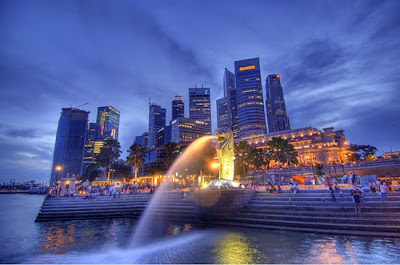 If you are in the market for a tripod, I do not know of a better time to buy one then right now! Why? You will find out in a moment, but first when should you use a tripod?
If you are in the market for a tripod, I do not know of a better time to buy one then right now! Why? You will find out in a moment, but first when should you use a tripod?You should use a tripod when you are shooting in low-light, when you are looking to record exacting sharpness, when you are shooting with really long lenses, when you are shooting a family portrait, when you are shooting a self-portrait, when you are shooting a waterfall at a 1/4 second, when you are shooting a city scene at night, when you are shooting with Graduated ND filters.
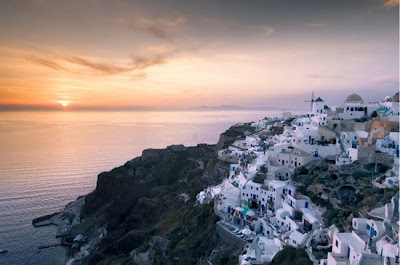 When you are doing close-up photography, when you want to keep your horizon lines straight, when you need to lock up your mirror, when you are zooming during long exposures, when you get down low to foreground interest and you want a great depth of field, when you shoot in a meadow of flowers and you are isolating a single flower, when you are shooting with rear-curtain sync and your flash.
When you are doing close-up photography, when you want to keep your horizon lines straight, when you need to lock up your mirror, when you are zooming during long exposures, when you get down low to foreground interest and you want a great depth of field, when you shoot in a meadow of flowers and you are isolating a single flower, when you are shooting with rear-curtain sync and your flash.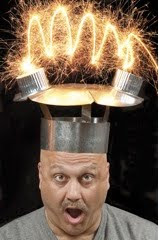 When you are shooting star trails at night, when you shoot the moon, when you shoot a sunset at the beach, when you want to shoot a panorama.
When you are shooting star trails at night, when you shoot the moon, when you shoot a sunset at the beach, when you want to shoot a panorama.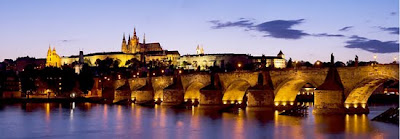
When you...Finally, when shooting any subject with your tripod, make it a point to use either the camera's self timer or a cable release to trip the shutter release.
So, why is now the best time to buy a tripod? Because the BEST tripod that I personally have been waiting on for the past 12-months has finally come on the market, and at a price that is so darn affordable, you'll be tempted to buy two of them! (But don't! This is a tripod, not a plasma TV!)
Our great friends at Adorama have in stock ready for shipment, the all new Flashpoint Carbon Fiber Tripods with the Adorama Flip Lock designed leg release system which uses a patented process for making the plastic from different polymers at an extremely high temperature to create a lock that will not fail. These non-slip flip locks will keep the legs locked into position. Set up and closing time becomes fast and without effort. A victory for sure for those of us who have loathed the "twist/lock legs"!
The Flashpoint Carbon Fiber material is an all new material and is considered a major break through by combining traditional carbon fiber with latest carbon fiber tube technique-bullet proof fiber complex (patented). The anti-resonance effect is increased by 60% over the old technology. The major benefit to this carbon fiber over all others is greater rigidity, which will prevent tube rupture.
Each leg can be set at multiple angles and the center column can be separated into a low column for ground level use.
They all include a bubble level and have a rubber pads on the bottom of the legs with retractable ground spikes for use in rugged terrain. Leg friction can be adjusted to match the needs of the photographer. And in case you didn't know, Carbon fiber is more than 40% lighter than the same item made in aluminum. You will indeed be feeling a "bit light in your loafers" as you walk those mountain trails with one of these tripods! And now check out the specs and of course you can order by clicking HERE!
Tuesday, June 22, 2010
ITS ALL ABOUT RELATIONSHIPS!
Let me ask you, "What is the most important element in a group shot? "
Sure you want everyone to look their best, but the essential ingredient is more than
smiles, eyes looking at the lens, and natural poses.
What makes or breaks the group shot are the relationships portrayed - the subtext, the connections. These nuances require collaboration. The subjects must relax, remove the masks, and be themselves.
As a children and family portrait photographer, I often photograph groups and I always do my homework. I know the environment and the lighting beforehand so that I can go ahead and work with the group and not be tinkering with my camera and the settings.
 I also work fast. The nine-month-old in this group photo was cooperating, but I knew
I also work fast. The nine-month-old in this group photo was cooperating, but I knew
that would change. To accomplish the photo, I had two assistants standing three feet high on step stools and holding a large diffusing screen (a 42-inch translucent zip disc) to cut down the harsh 5:00 PM (EST) September sun. Indian summer sunlight casts a beatific glow, but it is a challenge to work with.
Typically, I shoot on manual exposure mode and select the ISO required to shoot with the aperture/shutter combination I want. For this session, I wanted to shoot with an aperture of f/8 or f/11 (to ensure sharp focus on more than one focal plane) and a shutter of 1/100 since I was handholding my Canon 5D with a 24-105 mm lens (the rule of thumb to avoid camera shake is 1/focal length of the lens). I settled on an ISO of 1000.
 To fine tune the exposure, I took an incident reading, placing my handheld under an
To fine tune the exposure, I took an incident reading, placing my handheld under an
assistantʼs chin, pointing to the lens (or where it will be) to get an exposure comparison. I then fired off a few test shots (my assistant as a model) and used the cameraʼs histogram to fine tune my exposure. I was looking for good facial values; the majority of pixels to fall in the middle of the histogram.
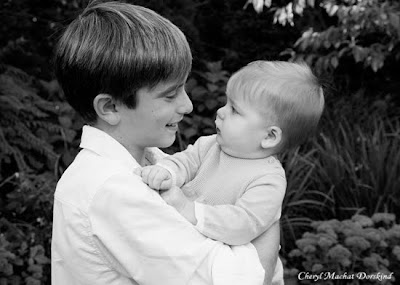 This particular client prefers black and white images, but I will shoot in RAW and convert later using NIK Silver Effex or the Adobe Photoshop b/w adjustment layer. Even though my client wants black and white, I would rather have color files in case she also wants color photos.
This particular client prefers black and white images, but I will shoot in RAW and convert later using NIK Silver Effex or the Adobe Photoshop b/w adjustment layer. Even though my client wants black and white, I would rather have color files in case she also wants color photos.
With group shots, I usually do not use a tripod because I move around so much. I often lie on the grass which is a great way to relax my clients.
Depending upon the age of the children, I will bring one or two, or sometimes three
assistants. With babies, I know I have a very brief window of opportunity to nail the
image. So the more hands the better.
I work with fill flash and sometimes reflectors. I use a "Pro -T" flash bracket and a
Canon Speedlite 580 EX II, with a Sto-Fen for a diffuser. Indoors I use the Gary Fong Cloud.
If the group is stationary, I have more ability to use the reflectors. But my style is to
encourage a certain degree of movement, so reflectors are not always practical. Some times diffusers are the rule, as the bright sun needs to be filtered to block the harsh rays.
I use a "jill-e" black leather camera bag (some people have told me it looks like a Marc Jacobs bag). In addition to my camera, lens, flash, and bracket, I always carry some anti frizz hair gel, mosquito spray, a brush, and some bubbles. In my car trunk I have a step stool and a tripod.
If you are interested in photographing children and families, and are thinking about becoming a child photographer, then join me for a class. Many photographers have begun their careers by photographing their own children. Let me help you learn how to put it all together.
I also teach "All About Color" and "Painting Photos". Feel free to send me a note:
cheryl@cherylmachatdorskind.com
All My Best,
Cheryl Machat Dorskind
Instructor/PPSOP.com
Sure you want everyone to look their best, but the essential ingredient is more than
smiles, eyes looking at the lens, and natural poses.
What makes or breaks the group shot are the relationships portrayed - the subtext, the connections. These nuances require collaboration. The subjects must relax, remove the masks, and be themselves.
As a children and family portrait photographer, I often photograph groups and I always do my homework. I know the environment and the lighting beforehand so that I can go ahead and work with the group and not be tinkering with my camera and the settings.
 I also work fast. The nine-month-old in this group photo was cooperating, but I knew
I also work fast. The nine-month-old in this group photo was cooperating, but I knewthat would change. To accomplish the photo, I had two assistants standing three feet high on step stools and holding a large diffusing screen (a 42-inch translucent zip disc) to cut down the harsh 5:00 PM (EST) September sun. Indian summer sunlight casts a beatific glow, but it is a challenge to work with.
Typically, I shoot on manual exposure mode and select the ISO required to shoot with the aperture/shutter combination I want. For this session, I wanted to shoot with an aperture of f/8 or f/11 (to ensure sharp focus on more than one focal plane) and a shutter of 1/100 since I was handholding my Canon 5D with a 24-105 mm lens (the rule of thumb to avoid camera shake is 1/focal length of the lens). I settled on an ISO of 1000.
 To fine tune the exposure, I took an incident reading, placing my handheld under an
To fine tune the exposure, I took an incident reading, placing my handheld under anassistantʼs chin, pointing to the lens (or where it will be) to get an exposure comparison. I then fired off a few test shots (my assistant as a model) and used the cameraʼs histogram to fine tune my exposure. I was looking for good facial values; the majority of pixels to fall in the middle of the histogram.
 This particular client prefers black and white images, but I will shoot in RAW and convert later using NIK Silver Effex or the Adobe Photoshop b/w adjustment layer. Even though my client wants black and white, I would rather have color files in case she also wants color photos.
This particular client prefers black and white images, but I will shoot in RAW and convert later using NIK Silver Effex or the Adobe Photoshop b/w adjustment layer. Even though my client wants black and white, I would rather have color files in case she also wants color photos.With group shots, I usually do not use a tripod because I move around so much. I often lie on the grass which is a great way to relax my clients.
Depending upon the age of the children, I will bring one or two, or sometimes three
assistants. With babies, I know I have a very brief window of opportunity to nail the
image. So the more hands the better.
I work with fill flash and sometimes reflectors. I use a "Pro -T" flash bracket and a
Canon Speedlite 580 EX II, with a Sto-Fen for a diffuser. Indoors I use the Gary Fong Cloud.
If the group is stationary, I have more ability to use the reflectors. But my style is to
encourage a certain degree of movement, so reflectors are not always practical. Some times diffusers are the rule, as the bright sun needs to be filtered to block the harsh rays.
I use a "jill-e" black leather camera bag (some people have told me it looks like a Marc Jacobs bag). In addition to my camera, lens, flash, and bracket, I always carry some anti frizz hair gel, mosquito spray, a brush, and some bubbles. In my car trunk I have a step stool and a tripod.
If you are interested in photographing children and families, and are thinking about becoming a child photographer, then join me for a class. Many photographers have begun their careers by photographing their own children. Let me help you learn how to put it all together.
I also teach "All About Color" and "Painting Photos". Feel free to send me a note:
cheryl@cherylmachatdorskind.com
All My Best,
Cheryl Machat Dorskind
Instructor/PPSOP.com
Saturday, June 19, 2010
IDEA'S ARE LIMITED ONLY BY OUR IMAGINATION!
The great folks at Bogen do make a host of fantastic tripods but they also make a host of attachments that allow the photographer to put a camera just about anywhere he/she can imagine. One of my favorite gadgets of theirs is called the Avenger Pump Suction Cup.
With the aid of the Avenger 'Super' Suction Cup, (and boy do I ever mean 'Super Suction') I was able to mount my camera and fish eye lens on the hood of my friend Phillipe's car intent on firing off a number of exposures as we drove through several long tunnels. And to add a bit of 'horror' to this motion-filled idea, Phillipe and I donned masks, (they were having a Halloween close-out sale at the local variety store). I'm the passenger and Phillipe is driving.
 Of course I wanted to record the sense of motion that one experiences when driving through tunnels, which meant I would need a 'slow' shutter speed of at least 1/2 if not a full second. And in order to determine what aperture I would need to use at these speeds I needed to take a meter reading under a lighting condition that would be similar to the light we would find inside the tunnel. Getting that meter reading actually proved rather easy, as I suggested that we first drive through the tunnel, without the camera mounted on the car, but rather with the sunroof open, which then allowed me to shoot down onto the hood of the car and take my meter reading. Once we were inside the tunnel I stood up, and with my 17-55mm lens and camera set to 100 ISO, I simply pointed it at the hood of the car in Aperture Priority and found that when I chose f/8 I had a correct exposure indication of 1/2 second and of course at f/11 the correct exposure was now indicating1 second.
Of course I wanted to record the sense of motion that one experiences when driving through tunnels, which meant I would need a 'slow' shutter speed of at least 1/2 if not a full second. And in order to determine what aperture I would need to use at these speeds I needed to take a meter reading under a lighting condition that would be similar to the light we would find inside the tunnel. Getting that meter reading actually proved rather easy, as I suggested that we first drive through the tunnel, without the camera mounted on the car, but rather with the sunroof open, which then allowed me to shoot down onto the hood of the car and take my meter reading. Once we were inside the tunnel I stood up, and with my 17-55mm lens and camera set to 100 ISO, I simply pointed it at the hood of the car in Aperture Priority and found that when I chose f/8 I had a correct exposure indication of 1/2 second and of course at f/11 the correct exposure was now indicating1 second.
After this first trip through the tunnel, we exited and pulled off to the side of the road. With the bright interior dome light on inside the car, I took another reading of Phillpe's face and discovered that also at f/11, I could get a correct exposure at one second. I had the 'numbers' and now we were all set. I chose to leave the camera in Aperture Priority Mode, rather than manual, knowing that if I set the aperture to f/11 the camera would record a correct exposure somewhere in the neighborhood of one second, depending on the varying degrees of brightness as we drove through the tunnel. So, with the camera in Aperture Priority Mode, the fish-eye lens set to f/11 and pointed at 'us', and with my remote triggering device mounted to the camera, we were ready to begin our journey through several long tunnels, but NOT before donning our ghoulish masks. I wanted this to be a 'ghoulish dream' kind of photo. As we drove through the tunnels, I would simply fire the camera from inside the car with the remote sending unit. After making several trips through the tunnels, we pulled over and I began a quick review of the images and it was clear that I had my shot.
I wanted to add that Phillipe's car is actually light blue and once inside the tunnel, it recorded an odd bronze cast that no amount of PhotoShop could repair. But it was also while trying to recover the light blue color in PhotoShop, that I came upon this 'wild' purple color and the more I viewed it the more I liked it so a purple car it is! This color was the result of 'playing' with both the Color Balance and Hue/Satruation controls in PhotoShop.
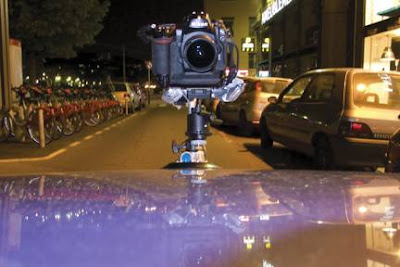 Here is the set-up with the camera and fish-eye lens suction cupped to the hood of Phillipe's car. Honestly, it was my experience that this Bogen Suction Cup made a bond that was as strong as steel! You will also need a Bogen mounting plate for the camera, which in turn gets attached to the suction cup.
Here is the set-up with the camera and fish-eye lens suction cupped to the hood of Phillipe's car. Honestly, it was my experience that this Bogen Suction Cup made a bond that was as strong as steel! You will also need a Bogen mounting plate for the camera, which in turn gets attached to the suction cup.
All My Best,
Bryan F Peterson
Founder/PPSOP.com
With the aid of the Avenger 'Super' Suction Cup, (and boy do I ever mean 'Super Suction') I was able to mount my camera and fish eye lens on the hood of my friend Phillipe's car intent on firing off a number of exposures as we drove through several long tunnels. And to add a bit of 'horror' to this motion-filled idea, Phillipe and I donned masks, (they were having a Halloween close-out sale at the local variety store). I'm the passenger and Phillipe is driving.
 Of course I wanted to record the sense of motion that one experiences when driving through tunnels, which meant I would need a 'slow' shutter speed of at least 1/2 if not a full second. And in order to determine what aperture I would need to use at these speeds I needed to take a meter reading under a lighting condition that would be similar to the light we would find inside the tunnel. Getting that meter reading actually proved rather easy, as I suggested that we first drive through the tunnel, without the camera mounted on the car, but rather with the sunroof open, which then allowed me to shoot down onto the hood of the car and take my meter reading. Once we were inside the tunnel I stood up, and with my 17-55mm lens and camera set to 100 ISO, I simply pointed it at the hood of the car in Aperture Priority and found that when I chose f/8 I had a correct exposure indication of 1/2 second and of course at f/11 the correct exposure was now indicating1 second.
Of course I wanted to record the sense of motion that one experiences when driving through tunnels, which meant I would need a 'slow' shutter speed of at least 1/2 if not a full second. And in order to determine what aperture I would need to use at these speeds I needed to take a meter reading under a lighting condition that would be similar to the light we would find inside the tunnel. Getting that meter reading actually proved rather easy, as I suggested that we first drive through the tunnel, without the camera mounted on the car, but rather with the sunroof open, which then allowed me to shoot down onto the hood of the car and take my meter reading. Once we were inside the tunnel I stood up, and with my 17-55mm lens and camera set to 100 ISO, I simply pointed it at the hood of the car in Aperture Priority and found that when I chose f/8 I had a correct exposure indication of 1/2 second and of course at f/11 the correct exposure was now indicating1 second. After this first trip through the tunnel, we exited and pulled off to the side of the road. With the bright interior dome light on inside the car, I took another reading of Phillpe's face and discovered that also at f/11, I could get a correct exposure at one second. I had the 'numbers' and now we were all set. I chose to leave the camera in Aperture Priority Mode, rather than manual, knowing that if I set the aperture to f/11 the camera would record a correct exposure somewhere in the neighborhood of one second, depending on the varying degrees of brightness as we drove through the tunnel. So, with the camera in Aperture Priority Mode, the fish-eye lens set to f/11 and pointed at 'us', and with my remote triggering device mounted to the camera, we were ready to begin our journey through several long tunnels, but NOT before donning our ghoulish masks. I wanted this to be a 'ghoulish dream' kind of photo. As we drove through the tunnels, I would simply fire the camera from inside the car with the remote sending unit. After making several trips through the tunnels, we pulled over and I began a quick review of the images and it was clear that I had my shot.
I wanted to add that Phillipe's car is actually light blue and once inside the tunnel, it recorded an odd bronze cast that no amount of PhotoShop could repair. But it was also while trying to recover the light blue color in PhotoShop, that I came upon this 'wild' purple color and the more I viewed it the more I liked it so a purple car it is! This color was the result of 'playing' with both the Color Balance and Hue/Satruation controls in PhotoShop.
 Here is the set-up with the camera and fish-eye lens suction cupped to the hood of Phillipe's car. Honestly, it was my experience that this Bogen Suction Cup made a bond that was as strong as steel! You will also need a Bogen mounting plate for the camera, which in turn gets attached to the suction cup.
Here is the set-up with the camera and fish-eye lens suction cupped to the hood of Phillipe's car. Honestly, it was my experience that this Bogen Suction Cup made a bond that was as strong as steel! You will also need a Bogen mounting plate for the camera, which in turn gets attached to the suction cup.All My Best,
Bryan F Peterson
Founder/PPSOP.com
Saturday, June 12, 2010
Every photograph is a 'lie', yet within that 'lie' is a mountain of truth, a truth that is perhaps best defined as "The Sizzle!"
As you may recall, a few days ago, I raised the question of 'integrity' when it comes to the dramatic alteration of one's photograph via Photoshop. In case you missed it, I have uploaded both of the photographs again and the image on top is the original while the image below was altered via Photoshop; namely I replaced the foreground grasses and distant road with another photograph that included a foreground of a sandy beach.
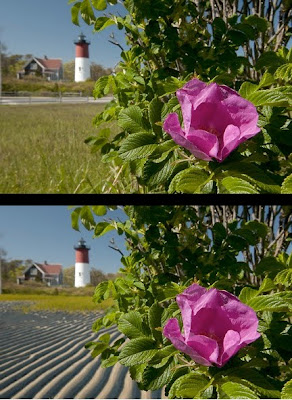 I received more than 450 emails to my question, "Do we have an obligation to tell the viewer when a photograph has been dramatically altered in Photo-Shop?" and the votes are now in!
I received more than 450 emails to my question, "Do we have an obligation to tell the viewer when a photograph has been dramatically altered in Photo-Shop?" and the votes are now in!
Before sharing with you the results of this unscientific survey, many of you made it clear that there is only one area in photography that is deserving of the "death penalty" if one is found to have dramatically altered an image and that is the area of Photo-Journalism/Documentary Photography. But, and to my amazement, 41% of you felt that when a photographer dramatically alters an image he or she is NOT obligated to tell anyone, unless asked. And a few of you even stated, that if asked, you would simply say, "That's none of your business!" There were a variety of reasons why most felt they had no obligation to tell anyone if the image was dramatically altered, but suffice it to say, all of the reasons could be easily quantified as "artistic license".
Personally, I have NO problem with any image that has been dramatically altered, as long as it is 'believable' OR so obviously altered that it's not even a question e.g. fantasy, dream-like photographs. I don't mind the 'lie' that is created from a dramatically altered image, since I have felt for years that every photograph is a 'lie' anyway, but my problem with the dramatically altered 'lie' is that it can lead one to believe that a given landscape or cityscape really does "look like that" when, as it turns out, there is no such place on earth.
Several years ago, I came upon a really beautiful image of a street scene in Paris. It was an image I saw on a photographers website. In the foreground was the street sign, Rue Ravoli. A few weeks later I was in Paris and I tracked down this 'street' and as you might have guessed, the street I vividly recalled in the photograph was nothing like the street I was standing on. There were only two buildings that I recognized and everything else on that street was an obvious composite of other shops and cafes that were probably taken in other parts of Paris. On a strictly personal level, I tipped my hat to the photographer who obviously possessed some terrific Photo-Shop skills. It was clearly one of the best Photo-Shop composites I had ever seen. But, on the other hand, I was disappointed that such a place did not exist, if only because I wanted to see what I might be able to do, photographically, on that same street.
If you know me at all, I am 'old school'; I am a big fan of "getting it right in camera". For the longest time I have taken great pride in meeting the personal challenge of creating unique images and since the advent of Photoshop I have at times felt quite smug, knowing that I got 'that' image without the use of Photoshop. I love it when someone asks, "Did you do 'that' in Photoshop?" and with the biggest smile across my face, I say, honestly and often emphatically, "Nope, it was all done in camera!"
Since last week however, I now find myself thinking about my "get it done in camera" attitude and I must confess, I have now come under my own suspicion!
How many times have I 'dramatically altered' a scene before actually photographing it? In 35 years of shooting that answer would be at least a few dozen times, I am sure! One such scene that I recall vividly stands out more than any other and ironically it also involves a city street, a city street that was dramatically altered, all for the sake of a photograph. I was hired by an advertising agency to photograph a European street scene, complete with a Bakery, Café and a Newsstand. I scouted various locations and hired set-builders, stylists and of course 'European' models and several weeks later the shot of the European street was taken in the early morning hours in downtown Portland, Oregon!
The shoot itself lasted about two hours and by that afternoon, all that was left of the European street scene were 11 rolls of 36-exposure slide film. The 'lie' had been successfully recorded and now that 'lie' would continue as the State of Oregon Tourism Dept. began running two-page spread advertisements in many national magazines, promoting Portland as a European city alternative.
This is of course my most extreme example of being party to a dramatically altered image. Clearly, most shooters don't think twice about dramatically altering the scene before them, as long as any changes are done before they take the picture. Why is that approach any less 'dishonest' than the dramatically altered images done by others with the aid of Photoshop? As for me, I had been struggling with that question all week.
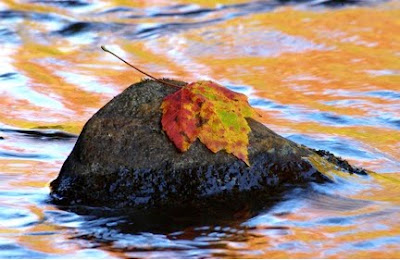 What if I make only minor alterations to a scene before I take the picture? Am I still 'guilty' of altering an image if I ADD or SUBTRACT just a few things? The image above has been altered. How has it been altered? I placed the leaf you see on that rock there, in full view of several of my students. Does it look 'natural', believable? Before answering that there is another part of this story that you need to hear. Within ten minutes of placing that leaf on this rock, several other photographers who were not part of my workshop had arrived in the same area, and myself and several of my students overheard the following remark made by one of the photographers, "Wow, check out the leaf on the rock!" And without hesitation both of these photographers set up their cameras and tripods and fired away. As far as they were concerned, the leaf that on that rock was natural!
What if I make only minor alterations to a scene before I take the picture? Am I still 'guilty' of altering an image if I ADD or SUBTRACT just a few things? The image above has been altered. How has it been altered? I placed the leaf you see on that rock there, in full view of several of my students. Does it look 'natural', believable? Before answering that there is another part of this story that you need to hear. Within ten minutes of placing that leaf on this rock, several other photographers who were not part of my workshop had arrived in the same area, and myself and several of my students overheard the following remark made by one of the photographers, "Wow, check out the leaf on the rock!" And without hesitation both of these photographers set up their cameras and tripods and fired away. As far as they were concerned, the leaf that on that rock was natural!
The debate over 'natural' or 'altered' images is really OLD NEWS! In fact it can be argued that every lens choice, every point of view, every 'creative exposure', every filter, to name a few from the list, are all guilty of 'altering' an image. As far as I am concerned, you can even add the mere act of framing the image in-camera as another example of altering an image! Let's look at several examples and see if you don't agree.
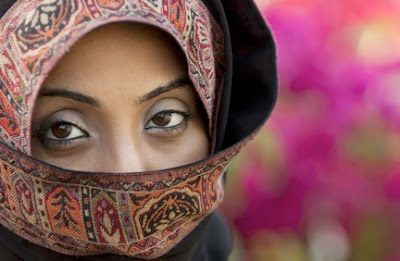 The image you see here has been altered dramatically, yet I will add that it was altered 100% in-camera and without the aid of Photoshop, NOT that that should matter! It was altered 100% by LENS CHOICE, POINT OF VIEW and a LARGE LENS OPENING. We can all agree that the woman you see here is probably of Middle-Eastern descent, but after that, it's anybody's guess what the rest of the story might be.
The image you see here has been altered dramatically, yet I will add that it was altered 100% in-camera and without the aid of Photoshop, NOT that that should matter! It was altered 100% by LENS CHOICE, POINT OF VIEW and a LARGE LENS OPENING. We can all agree that the woman you see here is probably of Middle-Eastern descent, but after that, it's anybody's guess what the rest of the story might be.
One thing is sure. Without benefit of the photograph below, you would have never guessed that this image was made in a nursery next to a trailer, and with the aid of an assistant who is reflecting some warm light onto her face. In addition, the model did not have the right pins to hold her headscarf in place so she had to use one of her hands to hold the headscarf in place while I took the shot! With the telephoto lens and a large aperture, I was able to render a shallow depth of field AND with the right point of view I was also able to avoid recording any part of the trailer in the background. When we consider the subject and the surroundings, there is no question that I have dramatically altered the scene to get to my end result.
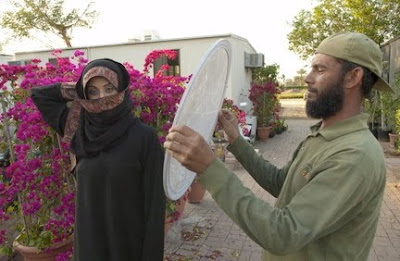 One more example and I will then turn this debate over to you. In the photograph below we see a woman in a red sweater, doing her laundry, along with several other women in the background, walking in the shadows. Once again, it's anybody's guess what the rest of the story might be, but rest assured, the image you are looking at has also been 'dramatically altered'. It is an image that was cropped, in camera, by the use of a long telephoto lens and further 'altered' by manipulating a deliberate in-camera under-exposure so the shadows would go black. And again, not that it matters, but this image was also done in-camera.
One more example and I will then turn this debate over to you. In the photograph below we see a woman in a red sweater, doing her laundry, along with several other women in the background, walking in the shadows. Once again, it's anybody's guess what the rest of the story might be, but rest assured, the image you are looking at has also been 'dramatically altered'. It is an image that was cropped, in camera, by the use of a long telephoto lens and further 'altered' by manipulating a deliberate in-camera under-exposure so the shadows would go black. And again, not that it matters, but this image was also done in-camera.
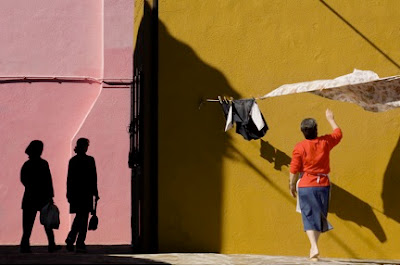 As you now have the benefit of the 'bigger' picture below, it becomes readily apparent that the above image was indeed altered. Again, with my telephoto lens, I was able to cut through the surrounding 'clutter' and arrive at what I determined to be the much cleaner composition in the photograph above. So, again, by the mere act of LENS CHOICE, I have created a compelling composition of a very small part of the larger scene before me. Like it or not, I am once again, guilty of altering an image.
As you now have the benefit of the 'bigger' picture below, it becomes readily apparent that the above image was indeed altered. Again, with my telephoto lens, I was able to cut through the surrounding 'clutter' and arrive at what I determined to be the much cleaner composition in the photograph above. So, again, by the mere act of LENS CHOICE, I have created a compelling composition of a very small part of the larger scene before me. Like it or not, I am once again, guilty of altering an image.
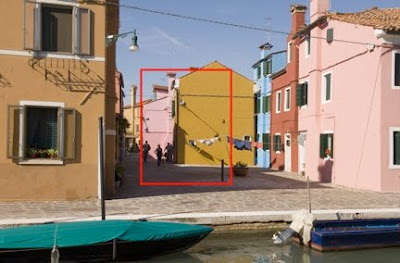 Every photograph is a 'lie', yet within that 'lie' is a mountain of truth, a truth that is perhaps best defined as a "The Sizzle!"
Every photograph is a 'lie', yet within that 'lie' is a mountain of truth, a truth that is perhaps best defined as a "The Sizzle!"
Years ago, like many photographers who are just starting out, I needed to have a 'real' job to support myself initially. One of those jobs was selling insulation and storm windows to homeowners and I remember the sales manager's advice to all of us in our weekly sales meetings-"Sell the sizzle not the steak!" In other words, appeal to the customer's emotions (the"sizzle") and when you sell the sizzle, most customers will be quick to buy the steak!
When I think about memorable photographs, images that truly do leave a lasting impression, it's fair to say they all have a common thread. They are images that "sizzle", they are images that excite or ignite the emotions of the viewer.
Your camera's viewfinder, combined with a given lens choice, point of view and an understanding of light, exposure and composition fundamentals, is able to record an image of great emotion, regardless of the overall truth that was surrounding the image.
I can think of countless images I have taken that suggested 'peace', 'joy', 'elation', 'sensuality' or 'sorrow'. Yet, if you saw the 'big picture', your reaction might be quite different. Prior to the digital age we now live in, all photographs were made with film and for those of us who shot color slide film exclusively, myself included, a cloud of suspicion rarely hung over us. (Make note of that word 'suspicion'.)
Since the digital age, and with greater frequency, the emails I receive from readers raise the question, "Did you do that in Photoshop?" It is a fair question, and for the most part, the answer is no, but the fact remains, a cloud of suspicion is a constant in my photographic life today as it is or many other shooters. However, just this past week, I have concluded, that it has been my attitude towards "dramatically altering an image in Photoshop" that is behind this cloud of suspicion because I, like so many others have been preaching for way too long that it is somehow far more noble and far more an indicator of one's creativity if you can get the shot in camera! Yet, as I have just shared with you, I now realize that I have been altering images, sometimes dramatically, in camera for years, but what is the difference between doing it in camera or in Photoshop? Seriously, what is the difference!? I am not only 'guilty' of altering images for years, but also equally 'guilty' of arrogance!
Going forward, I will continue to use the same barometer I have used for years when looking at the work of other photographers; "Does this image make me feel, does it excite or ignite my emotions, does the image sizzle? Whether or not its 'real' or believable is really NOT important, (crime scene photographs, passport and drivers license photographs being the exception!)
And if and when I start dramatically altering images with the aid of Photoshop, I will be the first to answer, "Yes I did!" should anyone ask if I did that in Photoshop. I finally understand that for many shooters, Photoshop is their main tool for creating much of their compelling imagery. And if it's Photoshop that accounts for much of your "sizzling" work I'll still gladly be buying your steak!
To be clear I am a big believer in getting most if not all of my 'dramatic alterations' done in-camera; moving objects, adding objects, subtracting objects, creating blur, adding sharpness, seeking out appropriate backgrounds, manipulating exposure, or the occasional use of my flash to create sunlight and of course focusing on the final arrangement, (lens choice and point of view), which will result in the most effective composition. My reason is a simple one: doing my dramatic alterations in-camera is simply quicker than the hour or so I might need to do the same thing in Photo-Shop.
And finally in closing, I wanted to share with you another example where, truth be told, I have dramatically altered the image. My first dramatic alteration to this scene was adding a seashell, on its side no less, to an otherwise empty oasis of sand. My second dramatic alteration was adding light where NO light ever existed, thanks in large part to a small flashlight. My third and somewhat less dramatic alteration was setting my White Balance to Incandescent/Tungsten. This made the overall scene blue. My fourth and even less of a dramatic alteration was the use of a full frame fish-eye lens. Dramatically altered? You bet, but hey, at least I didn't use Photo-Shop-LOL!
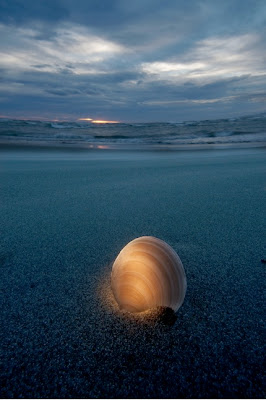 Yes, let me know your thoughts if you feel compelled to share them in the comments below!
Yes, let me know your thoughts if you feel compelled to share them in the comments below!
 I received more than 450 emails to my question, "Do we have an obligation to tell the viewer when a photograph has been dramatically altered in Photo-Shop?" and the votes are now in!
I received more than 450 emails to my question, "Do we have an obligation to tell the viewer when a photograph has been dramatically altered in Photo-Shop?" and the votes are now in!Before sharing with you the results of this unscientific survey, many of you made it clear that there is only one area in photography that is deserving of the "death penalty" if one is found to have dramatically altered an image and that is the area of Photo-Journalism/Documentary Photography. But, and to my amazement, 41% of you felt that when a photographer dramatically alters an image he or she is NOT obligated to tell anyone, unless asked. And a few of you even stated, that if asked, you would simply say, "That's none of your business!" There were a variety of reasons why most felt they had no obligation to tell anyone if the image was dramatically altered, but suffice it to say, all of the reasons could be easily quantified as "artistic license".
Personally, I have NO problem with any image that has been dramatically altered, as long as it is 'believable' OR so obviously altered that it's not even a question e.g. fantasy, dream-like photographs. I don't mind the 'lie' that is created from a dramatically altered image, since I have felt for years that every photograph is a 'lie' anyway, but my problem with the dramatically altered 'lie' is that it can lead one to believe that a given landscape or cityscape really does "look like that" when, as it turns out, there is no such place on earth.
Several years ago, I came upon a really beautiful image of a street scene in Paris. It was an image I saw on a photographers website. In the foreground was the street sign, Rue Ravoli. A few weeks later I was in Paris and I tracked down this 'street' and as you might have guessed, the street I vividly recalled in the photograph was nothing like the street I was standing on. There were only two buildings that I recognized and everything else on that street was an obvious composite of other shops and cafes that were probably taken in other parts of Paris. On a strictly personal level, I tipped my hat to the photographer who obviously possessed some terrific Photo-Shop skills. It was clearly one of the best Photo-Shop composites I had ever seen. But, on the other hand, I was disappointed that such a place did not exist, if only because I wanted to see what I might be able to do, photographically, on that same street.
If you know me at all, I am 'old school'; I am a big fan of "getting it right in camera". For the longest time I have taken great pride in meeting the personal challenge of creating unique images and since the advent of Photoshop I have at times felt quite smug, knowing that I got 'that' image without the use of Photoshop. I love it when someone asks, "Did you do 'that' in Photoshop?" and with the biggest smile across my face, I say, honestly and often emphatically, "Nope, it was all done in camera!"
Since last week however, I now find myself thinking about my "get it done in camera" attitude and I must confess, I have now come under my own suspicion!
How many times have I 'dramatically altered' a scene before actually photographing it? In 35 years of shooting that answer would be at least a few dozen times, I am sure! One such scene that I recall vividly stands out more than any other and ironically it also involves a city street, a city street that was dramatically altered, all for the sake of a photograph. I was hired by an advertising agency to photograph a European street scene, complete with a Bakery, Café and a Newsstand. I scouted various locations and hired set-builders, stylists and of course 'European' models and several weeks later the shot of the European street was taken in the early morning hours in downtown Portland, Oregon!
The shoot itself lasted about two hours and by that afternoon, all that was left of the European street scene were 11 rolls of 36-exposure slide film. The 'lie' had been successfully recorded and now that 'lie' would continue as the State of Oregon Tourism Dept. began running two-page spread advertisements in many national magazines, promoting Portland as a European city alternative.
This is of course my most extreme example of being party to a dramatically altered image. Clearly, most shooters don't think twice about dramatically altering the scene before them, as long as any changes are done before they take the picture. Why is that approach any less 'dishonest' than the dramatically altered images done by others with the aid of Photoshop? As for me, I had been struggling with that question all week.
 What if I make only minor alterations to a scene before I take the picture? Am I still 'guilty' of altering an image if I ADD or SUBTRACT just a few things? The image above has been altered. How has it been altered? I placed the leaf you see on that rock there, in full view of several of my students. Does it look 'natural', believable? Before answering that there is another part of this story that you need to hear. Within ten minutes of placing that leaf on this rock, several other photographers who were not part of my workshop had arrived in the same area, and myself and several of my students overheard the following remark made by one of the photographers, "Wow, check out the leaf on the rock!" And without hesitation both of these photographers set up their cameras and tripods and fired away. As far as they were concerned, the leaf that on that rock was natural!
What if I make only minor alterations to a scene before I take the picture? Am I still 'guilty' of altering an image if I ADD or SUBTRACT just a few things? The image above has been altered. How has it been altered? I placed the leaf you see on that rock there, in full view of several of my students. Does it look 'natural', believable? Before answering that there is another part of this story that you need to hear. Within ten minutes of placing that leaf on this rock, several other photographers who were not part of my workshop had arrived in the same area, and myself and several of my students overheard the following remark made by one of the photographers, "Wow, check out the leaf on the rock!" And without hesitation both of these photographers set up their cameras and tripods and fired away. As far as they were concerned, the leaf that on that rock was natural! The debate over 'natural' or 'altered' images is really OLD NEWS! In fact it can be argued that every lens choice, every point of view, every 'creative exposure', every filter, to name a few from the list, are all guilty of 'altering' an image. As far as I am concerned, you can even add the mere act of framing the image in-camera as another example of altering an image! Let's look at several examples and see if you don't agree.
 The image you see here has been altered dramatically, yet I will add that it was altered 100% in-camera and without the aid of Photoshop, NOT that that should matter! It was altered 100% by LENS CHOICE, POINT OF VIEW and a LARGE LENS OPENING. We can all agree that the woman you see here is probably of Middle-Eastern descent, but after that, it's anybody's guess what the rest of the story might be.
The image you see here has been altered dramatically, yet I will add that it was altered 100% in-camera and without the aid of Photoshop, NOT that that should matter! It was altered 100% by LENS CHOICE, POINT OF VIEW and a LARGE LENS OPENING. We can all agree that the woman you see here is probably of Middle-Eastern descent, but after that, it's anybody's guess what the rest of the story might be.One thing is sure. Without benefit of the photograph below, you would have never guessed that this image was made in a nursery next to a trailer, and with the aid of an assistant who is reflecting some warm light onto her face. In addition, the model did not have the right pins to hold her headscarf in place so she had to use one of her hands to hold the headscarf in place while I took the shot! With the telephoto lens and a large aperture, I was able to render a shallow depth of field AND with the right point of view I was also able to avoid recording any part of the trailer in the background. When we consider the subject and the surroundings, there is no question that I have dramatically altered the scene to get to my end result.
 One more example and I will then turn this debate over to you. In the photograph below we see a woman in a red sweater, doing her laundry, along with several other women in the background, walking in the shadows. Once again, it's anybody's guess what the rest of the story might be, but rest assured, the image you are looking at has also been 'dramatically altered'. It is an image that was cropped, in camera, by the use of a long telephoto lens and further 'altered' by manipulating a deliberate in-camera under-exposure so the shadows would go black. And again, not that it matters, but this image was also done in-camera.
One more example and I will then turn this debate over to you. In the photograph below we see a woman in a red sweater, doing her laundry, along with several other women in the background, walking in the shadows. Once again, it's anybody's guess what the rest of the story might be, but rest assured, the image you are looking at has also been 'dramatically altered'. It is an image that was cropped, in camera, by the use of a long telephoto lens and further 'altered' by manipulating a deliberate in-camera under-exposure so the shadows would go black. And again, not that it matters, but this image was also done in-camera. As you now have the benefit of the 'bigger' picture below, it becomes readily apparent that the above image was indeed altered. Again, with my telephoto lens, I was able to cut through the surrounding 'clutter' and arrive at what I determined to be the much cleaner composition in the photograph above. So, again, by the mere act of LENS CHOICE, I have created a compelling composition of a very small part of the larger scene before me. Like it or not, I am once again, guilty of altering an image.
As you now have the benefit of the 'bigger' picture below, it becomes readily apparent that the above image was indeed altered. Again, with my telephoto lens, I was able to cut through the surrounding 'clutter' and arrive at what I determined to be the much cleaner composition in the photograph above. So, again, by the mere act of LENS CHOICE, I have created a compelling composition of a very small part of the larger scene before me. Like it or not, I am once again, guilty of altering an image. Every photograph is a 'lie', yet within that 'lie' is a mountain of truth, a truth that is perhaps best defined as a "The Sizzle!"
Every photograph is a 'lie', yet within that 'lie' is a mountain of truth, a truth that is perhaps best defined as a "The Sizzle!"Years ago, like many photographers who are just starting out, I needed to have a 'real' job to support myself initially. One of those jobs was selling insulation and storm windows to homeowners and I remember the sales manager's advice to all of us in our weekly sales meetings-"Sell the sizzle not the steak!" In other words, appeal to the customer's emotions (the"sizzle") and when you sell the sizzle, most customers will be quick to buy the steak!
When I think about memorable photographs, images that truly do leave a lasting impression, it's fair to say they all have a common thread. They are images that "sizzle", they are images that excite or ignite the emotions of the viewer.
Your camera's viewfinder, combined with a given lens choice, point of view and an understanding of light, exposure and composition fundamentals, is able to record an image of great emotion, regardless of the overall truth that was surrounding the image.
I can think of countless images I have taken that suggested 'peace', 'joy', 'elation', 'sensuality' or 'sorrow'. Yet, if you saw the 'big picture', your reaction might be quite different. Prior to the digital age we now live in, all photographs were made with film and for those of us who shot color slide film exclusively, myself included, a cloud of suspicion rarely hung over us. (Make note of that word 'suspicion'.)
Since the digital age, and with greater frequency, the emails I receive from readers raise the question, "Did you do that in Photoshop?" It is a fair question, and for the most part, the answer is no, but the fact remains, a cloud of suspicion is a constant in my photographic life today as it is or many other shooters. However, just this past week, I have concluded, that it has been my attitude towards "dramatically altering an image in Photoshop" that is behind this cloud of suspicion because I, like so many others have been preaching for way too long that it is somehow far more noble and far more an indicator of one's creativity if you can get the shot in camera! Yet, as I have just shared with you, I now realize that I have been altering images, sometimes dramatically, in camera for years, but what is the difference between doing it in camera or in Photoshop? Seriously, what is the difference!? I am not only 'guilty' of altering images for years, but also equally 'guilty' of arrogance!
Going forward, I will continue to use the same barometer I have used for years when looking at the work of other photographers; "Does this image make me feel, does it excite or ignite my emotions, does the image sizzle? Whether or not its 'real' or believable is really NOT important, (crime scene photographs, passport and drivers license photographs being the exception!)
And if and when I start dramatically altering images with the aid of Photoshop, I will be the first to answer, "Yes I did!" should anyone ask if I did that in Photoshop. I finally understand that for many shooters, Photoshop is their main tool for creating much of their compelling imagery. And if it's Photoshop that accounts for much of your "sizzling" work I'll still gladly be buying your steak!
To be clear I am a big believer in getting most if not all of my 'dramatic alterations' done in-camera; moving objects, adding objects, subtracting objects, creating blur, adding sharpness, seeking out appropriate backgrounds, manipulating exposure, or the occasional use of my flash to create sunlight and of course focusing on the final arrangement, (lens choice and point of view), which will result in the most effective composition. My reason is a simple one: doing my dramatic alterations in-camera is simply quicker than the hour or so I might need to do the same thing in Photo-Shop.
And finally in closing, I wanted to share with you another example where, truth be told, I have dramatically altered the image. My first dramatic alteration to this scene was adding a seashell, on its side no less, to an otherwise empty oasis of sand. My second dramatic alteration was adding light where NO light ever existed, thanks in large part to a small flashlight. My third and somewhat less dramatic alteration was setting my White Balance to Incandescent/Tungsten. This made the overall scene blue. My fourth and even less of a dramatic alteration was the use of a full frame fish-eye lens. Dramatically altered? You bet, but hey, at least I didn't use Photo-Shop-LOL!
 Yes, let me know your thoughts if you feel compelled to share them in the comments below!
Yes, let me know your thoughts if you feel compelled to share them in the comments below!
Thursday, June 3, 2010
A Photographic Challenge
On a recent workshop in Cape Cod, my students and I had just parked our cars at a beach wayside parking lot and excitement filled the air! All of us would soon be facing one of several challenges that this weekend workshop presented.
When we think of a lighthouse, images of the lone sentinel are often associated with bluffs, cliffs or beach or a rocky out-cropping, often surrounded by pounding ocean surf.
 Well, as you can clearly see in the first photograph, this particular lighthouse was nowhere near any beach or pounding surf. In fact, I remember commenting to myself upon seeing this particular lighthouse "Whose idea was it to build a lighthouse in the woods?"
Well, as you can clearly see in the first photograph, this particular lighthouse was nowhere near any beach or pounding surf. In fact, I remember commenting to myself upon seeing this particular lighthouse "Whose idea was it to build a lighthouse in the woods?"
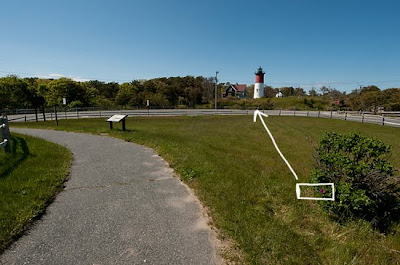 Most of the students walked ahead of me, proceeding across the street and up the small trail to the lighthouse. I and one other student stayed behind, as I felt the ONLY real shot worth taking here would be from the grassy area, where you can see a lone tea cup rose bush-(note the area that I have boxed).
Most of the students walked ahead of me, proceeding across the street and up the small trail to the lighthouse. I and one other student stayed behind, as I felt the ONLY real shot worth taking here would be from the grassy area, where you can see a lone tea cup rose bush-(note the area that I have boxed).
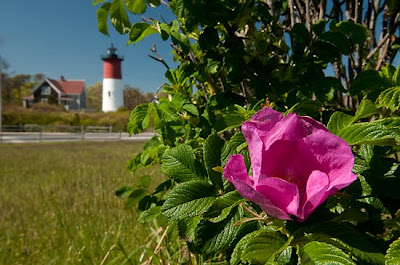 Combining my Nikkor 12-24mm lens with the Canon 500D close-up filter, I was able to move in really close to a single rose bloom and frame up the scene you see here.
Combining my Nikkor 12-24mm lens with the Canon 500D close-up filter, I was able to move in really close to a single rose bloom and frame up the scene you see here.
My initial reaction to this particular composition was fairly positive, BUT try as I might, I could not find a point of view that would allow me to 'lose' the roadway that is visible in the background. I did choose to shoot at a wide-open aperture, but even at wide open, (f/4) I was still unable to blur out the "unsightly" road in the background.
I did play around a bit with the Clone Tool in PS but that did nothing more than reveal a composition that now looked like I was trying to hide something. What's a photographer to do at a time like this?
At that moment I was struck with an idea as I recalled taking a number of beach landscapes the previous afternoon at a different location. You can see one of those beach landscapes here.
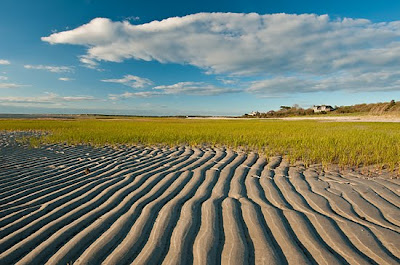 This particular image was also shot with my 12-24mm but at an aperture of f/16 and not surprising, unlike the wide-angle shot of the tea rose above, this image is super sharp, from front to back due to the use of the smaller aperture of f/16.
This particular image was also shot with my 12-24mm but at an aperture of f/16 and not surprising, unlike the wide-angle shot of the tea rose above, this image is super sharp, from front to back due to the use of the smaller aperture of f/16.
It was then that I got the idea! What if I were to combine the beachscape image with that of the lighthouse and tea rose? I would of course need to 'blur' the beachscape image so it would 'match' the natural blur of the lighthouse/tea rose image and once that was done, (using Gaussian Blur Tool in PhotoShop) I could then combine them and with the aid of a layer mask, "paint" this blurry beachscape into the lighthouse/tea rose scene and voila-that's exactly what I did!
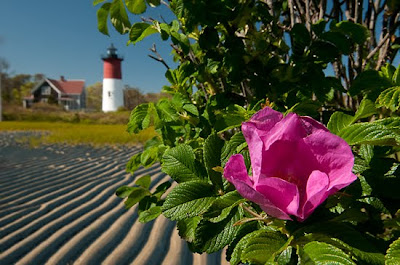 Here is that image for all to see (If you don't know a thing about LAYERS, get signed up for Jon Canfeld's class-NOW!)
Here is that image for all to see (If you don't know a thing about LAYERS, get signed up for Jon Canfeld's class-NOW!)
Assuming you have the knowledge on how to do a layer mask and assuming this was your shot, do you feel your viewing audience has the right to know that this image is a composite OR do you feel that it's nobody's business and unless someone asks, no one needs to know? If you have time comment here and let's get the discussion going!
When we think of a lighthouse, images of the lone sentinel are often associated with bluffs, cliffs or beach or a rocky out-cropping, often surrounded by pounding ocean surf.
 Well, as you can clearly see in the first photograph, this particular lighthouse was nowhere near any beach or pounding surf. In fact, I remember commenting to myself upon seeing this particular lighthouse "Whose idea was it to build a lighthouse in the woods?"
Well, as you can clearly see in the first photograph, this particular lighthouse was nowhere near any beach or pounding surf. In fact, I remember commenting to myself upon seeing this particular lighthouse "Whose idea was it to build a lighthouse in the woods?" Most of the students walked ahead of me, proceeding across the street and up the small trail to the lighthouse. I and one other student stayed behind, as I felt the ONLY real shot worth taking here would be from the grassy area, where you can see a lone tea cup rose bush-(note the area that I have boxed).
Most of the students walked ahead of me, proceeding across the street and up the small trail to the lighthouse. I and one other student stayed behind, as I felt the ONLY real shot worth taking here would be from the grassy area, where you can see a lone tea cup rose bush-(note the area that I have boxed). Combining my Nikkor 12-24mm lens with the Canon 500D close-up filter, I was able to move in really close to a single rose bloom and frame up the scene you see here.
Combining my Nikkor 12-24mm lens with the Canon 500D close-up filter, I was able to move in really close to a single rose bloom and frame up the scene you see here.My initial reaction to this particular composition was fairly positive, BUT try as I might, I could not find a point of view that would allow me to 'lose' the roadway that is visible in the background. I did choose to shoot at a wide-open aperture, but even at wide open, (f/4) I was still unable to blur out the "unsightly" road in the background.
I did play around a bit with the Clone Tool in PS but that did nothing more than reveal a composition that now looked like I was trying to hide something. What's a photographer to do at a time like this?
At that moment I was struck with an idea as I recalled taking a number of beach landscapes the previous afternoon at a different location. You can see one of those beach landscapes here.
 This particular image was also shot with my 12-24mm but at an aperture of f/16 and not surprising, unlike the wide-angle shot of the tea rose above, this image is super sharp, from front to back due to the use of the smaller aperture of f/16.
This particular image was also shot with my 12-24mm but at an aperture of f/16 and not surprising, unlike the wide-angle shot of the tea rose above, this image is super sharp, from front to back due to the use of the smaller aperture of f/16.It was then that I got the idea! What if I were to combine the beachscape image with that of the lighthouse and tea rose? I would of course need to 'blur' the beachscape image so it would 'match' the natural blur of the lighthouse/tea rose image and once that was done, (using Gaussian Blur Tool in PhotoShop) I could then combine them and with the aid of a layer mask, "paint" this blurry beachscape into the lighthouse/tea rose scene and voila-that's exactly what I did!
 Here is that image for all to see (If you don't know a thing about LAYERS, get signed up for Jon Canfeld's class-NOW!)
Here is that image for all to see (If you don't know a thing about LAYERS, get signed up for Jon Canfeld's class-NOW!)Assuming you have the knowledge on how to do a layer mask and assuming this was your shot, do you feel your viewing audience has the right to know that this image is a composite OR do you feel that it's nobody's business and unless someone asks, no one needs to know? If you have time comment here and let's get the discussion going!
Subscribe to:
Comments (Atom)











